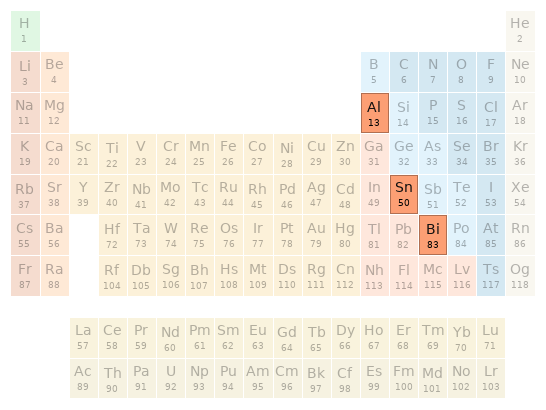Input interpretation

bismuth (chemical element) | aluminum (chemical element) | tin (chemical element)
Periodic table location

Periodic table location
Images

Images
Basic elemental properties
![| bismuth | aluminum | tin atomic symbol | Bi | Al | Sn atomic number | 83 | 13 | 50 short electronic configuration | [Xe]6s^24f^145d^106p^3 | [Ne]3s^23p^1 | [Kr]5s^24d^105p^2 Aufbau diagram | 6p 5d 4f 6s | 3p 3s | 5p 4d 5s block | p | p | p group | 15 | 13 | 14 period | 6 | 3 | 5 atomic mass | 208.9804 u | 26.9815385 u | 118.71 u half-life | 1.9×10^19 yr | (stable) | (stable)](../image_source/6fa4797bc80dc7b525239e4328421a0d.png)
| bismuth | aluminum | tin atomic symbol | Bi | Al | Sn atomic number | 83 | 13 | 50 short electronic configuration | [Xe]6s^24f^145d^106p^3 | [Ne]3s^23p^1 | [Kr]5s^24d^105p^2 Aufbau diagram | 6p 5d 4f 6s | 3p 3s | 5p 4d 5s block | p | p | p group | 15 | 13 | 14 period | 6 | 3 | 5 atomic mass | 208.9804 u | 26.9815385 u | 118.71 u half-life | 1.9×10^19 yr | (stable) | (stable)
Thermodynamic properties

| bismuth | aluminum | tin phase at STP | solid | solid | solid melting point | 271.3 °C | 660.32 °C | 231.93 °C boiling point | 1564 °C | 2519 °C | 2602 °C molar heat of fusion | 10.9 kJ/mol | 10.7 kJ/mol | 7 kJ/mol molar heat of vaporization | 160 kJ/mol | 293 kJ/mol | 290 kJ/mol specific heat at STP | 122 J/(kg K) | 904 J/(kg K) | 217 J/(kg K) (properties at standard conditions)
Material properties

| bismuth | aluminum | tin density | 9.78 g/cm^3 | 2.7 g/cm^3 | 7.31 g/cm^3 liquid density | 10.05 g/cm^3 | 2.375 g/cm^3 | 6.99 g/cm^3 molar volume | 21.37 cm^3/mol | 10 cm^3/mol | 16.24 cm^3/mol Mohs hardness | 2.25 (between gypsum and calcite) | 2.75 (between calcite and gypsum) | 1.5 (between talc and gypsum) Vickers hardness | | 167 MPa | Brinell hardness | 94.2 MPa | 245 MPa | 51 MPa bulk modulus | 31 GPa | 76 GPa | 58 GPa shear modulus | 12 GPa | 26 GPa | 18 GPa Young's modulus | 32 GPa | 70 GPa | 50 GPa Poisson ratio | 0.33 | 0.35 | 0.36 ultimate tensile strength | | | 220 MPa sound speed | 1790 m/s | 5100 m/s | 2500 m/s thermal expansion | 1.34×10^-5 K^(-1) | 2.31×10^-5 K^(-1) | 2.2×10^-5 K^(-1) thermal conductivity | 8 W/(m K) | 235 W/(m K) | 67 W/(m K) (properties at standard conditions)
Electromagnetic properties

| bismuth | aluminum | tin electrical type | conductor | conductor | conductor resistivity | 1.3×10^-6 Ω m (ohm meters) | 2.6×10^-8 Ω m (ohm meters) | 1.1×10^-7 Ω m (ohm meters) electrical conductivity | 770000 S/m (siemens per meter) | 3.8×10^7 S/m (siemens per meter) | 9.1×10^6 S/m (siemens per meter) magnetic type | diamagnetic | paramagnetic | diamagnetic volume magnetic susceptibility | -1.7×10^-4 | 2.11×10^-5 | -2.27×10^-5 mass magnetic susceptibility | -1.7×10^-8 m^3/kg (cubic meters per kilogram) | 7.8×10^-9 m^3/kg (cubic meters per kilogram) | -3.1×10^-9 m^3/kg (cubic meters per kilogram) molar magnetic susceptibility | -3.6×10^-9 m^3/mol (cubic meters per mole) | 2.1×10^-10 m^3/mol (cubic meters per mole) | -3.68×10^-10 m^3/mol (cubic meters per mole) work function | 4.34 eV (Polycrystalline) | (4.06 to 4.26) eV | 4.42 eV (Polycrystalline) threshold frequency | 1.049×10^15 Hz (hertz) | (9.817×10^14 to 1.03×10^15) Hz (hertz) | 1.069×10^15 Hz (hertz) superconducting point | | 1.175 K (kelvins) | 3.72 K (kelvins) color | (gray) | (silver) | (silver)
Reactivity

| bismuth | aluminum | tin valence | 5 | 3 | 4 electronegativity | 2.02 | 1.61 | 1.96 electron affinity | 91.2 kJ/mol (kilojoules per mole) | 42.5 kJ/mol (kilojoules per mole) | 107.3 kJ/mol (kilojoules per mole) first ionization energy | 703 kJ/mol (kilojoules per mole) | 577.5 kJ/mol (kilojoules per mole) | 708.6 kJ/mol (kilojoules per mole) ionization energies | 703 kJ/mol | 1610 kJ/mol | 2466 kJ/mol | 4370 kJ/mol | 5400 kJ/mol | 8520 kJ/mol | 577.5 kJ/mol | 1816.7 kJ/mol | 2744.8 kJ/mol | 11577 kJ/mol | 14842 kJ/mol | 18379 kJ/mol | 23326 kJ/mol | 27465 kJ/mol | 31853 kJ/mol | 38473 kJ/mol | 708.6 kJ/mol | 1411.8 kJ/mol | 2943 kJ/mol | 3930.3 kJ/mol | 7456 kJ/mol

Reactivity
Atomic properties

| bismuth | aluminum | tin term symbol | ^4S_(3/2) | ^2P_(1/2) | ^3P_0 atomic radius | 160 pm | 125 pm | 145 pm covalent radius | 148 pm | 121 pm | 139 pm van der Waals radius | | | 217 pm (electronic ground state properties)
Abundances

| bismuth | aluminum | tin universe abundance | 7×10^-8 mass% | 0.005 mass% | 4×10^-7 mass% solar abundance | 1×10^-6 mass% | 0.006 mass% | 9×10^-7 mass% meteorite abundance | 6.9×10^-6 mass% | 0.91 mass% | 1.2×10^-4 mass% crust abundance | 2.5×10^-6 mass% | 8.1 mass% | 2.2×10^-4 mass% ocean abundance | 2×10^-9 mass% | 5×10^-7 mass% | 1×10^-9 mass% human abundance | | 9×10^-5 mass% | 2×10^-5 mass% universe molar abundance | 4×10^-10 mol% | 2×10^-4 mol% | 4×10^-9 mol% solar molar abundance | 7×10^-9 mol% | 3×10^-4 mol% | 9.9×10^-9 mol% meteorite molar abundance | 5×10^-7 mol% | 0.67 mol% | 1.7×10^-5 mol% ocean molar abundance | 5.9×10^-11 mol% | 1.1×10^-7 mol% | 5.2×10^-11 mol% crust molar abundance | 2×10^-7 mol% | 6.3 mol% | 3.8×10^-5 mol% human molar abundance | | 2.1×10^-5 mol% | 1.1×10^-6 mol%